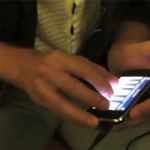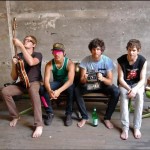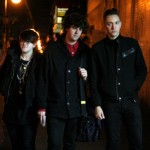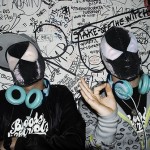The Decade in Indie
INDIE
“I opened up the door, and much to my surprise
The girls were wearing formals, and the boys were wearing ties
And I feel that I should mention that the band was at attention
They just stood there, oh so neat, while they played their swinging beat….
It’s been long overdue- we’ve been needing something new-
Sophisticated boom boom!”
- The Goodies, 1964
So have you heard? Indie rock is the choice of a new generation! Allegedly! Don’t let the exclamation points fool you into thinking I’m being sarcastic! Just try selling iPods or straight-leg jeans without knowing what fresh-faced guitar band is the hip new thing; just try telegraphing to audiences that a character on your television show is quite special and interesting. Stephenie Meyer, author of Twilight, not often accused of lacking insight into the hearts of America’s young, just told the world what her favorite records were this summer- Grizzly Bear and Animal Collective among them. (Do you think that’s awesome, or does it make you want to listen to nothing but rap mixtapes and noise?) I just read an article by a pretty likeable 57-year-old who’d decided indie rock was really interesting, that older people should check it out, and that Wilco were probably its godfathers. (That makes more sense than you’d think.) And it’s not like charts mean what they used to, but still: they’re home to the Shins (#2 record), Wilco (three records in the top 10), Arcade Fire (17 weeks), Interpol (24 weeks), and Death Cab for Cutie, who went to #1- as in, knocking off Neil Diamond and being replaced at the top by 3 Doors Down, that #1- without even much changing their sound from a decade ago. Toward the end of the 1990s the Flaming Lips were the kinds of weirdos who released an album you had to play on four different stereos at once, and now they get considered for Oklahoma’s state song and soundtrack moving funeral scenes in Mandy Moore movies. Let’s not even start on movies: Natalie Portman said the Shins would change your life, and she was in Star Wars.
Yay for Indie - The Shins
It’s not just music, either. I don’t know quite when it happened, but at some point a certain vague strain of “indie” dropped its last vestiges of seeming weird and became a commonplace- sort of like in Britain, where “indie” has long been synonymous with the normal guitar bands people find fashionable. When those I’m-a-Mac, I’m-a-PC commercials came out, I even saw some ad critic describe Justin Long’s Mac guy as an “indie type.” Why? He’s just a young middle-class-looking white guy with a haircut. (I’d be more aghast, except it’s actually not hard to imagine him telling you about the New Pornographers.) And soon enough any film, book, or cultural product that came anywhere near a certain sensibility- anything anyone would describe as “quirky” or cleverish or tender- fell in the indie bucket, too: Garden State with its hilarious Shins scene, Wes Anderson movies, Dave Eggers (??),Juno, Zooey Deschanel’s general existence, private colleges, button shirts, the Internet, IKEA, Miracle Whip, literacy, you tell me. The sensibility used to seem rarer, and then, I suppose, half the people attracted to it grew up and got creative jobs and now it floats everywhere. So huge swathes of twentysomethings, like anyone with a college education or a Mac or a strummy guitar record: indie, apparently? Which is allegedly quite the thing these days.
I’m actually not mocking or complaining. I have an ulterior motive. I mention all this because I’m positive that some of you read the above in a neutral, casual way, while others of you, having gotten through it, are right now actively gagging and fuming and experiencing some very visceral squirming, and if you check your reflection in the computer screen you will look approximately like Homer Simpson when he’s choking Bart. Because you hate this stuff. And what I want to tell you today is why that split- the neutral reading versus the visceral tooth-grinding hate-that-stuff feeling- is precisely why I’m really, really excited about what might happen to indie over the next decade.
Here’s the thing: “indie” has always been a baggy, contingent word, and the whole loose umbrella of stuff that gets considered “indie” has usually included huge splits and tensions. Back in the 1980s, for instance, there was a major difference between hardcore punks and what kids in my hometown would continue to refer to as “wavers,” as in new wave: fans of stylish British bands and synthesizers, drama-club Morrissey types. But by the end of the 80s, as it happened, there had emerged this crop of bands that seemed to resolve some of that punks-versus-wavers tension, bringing together parts of both camps- a little thrash/trash/noise and a little arty/stylish/pop- under one big tent. I don’t think it’s an accident that some of those bands, like Sonic Youth or Pixies, are still big tentpoles of what we now think of as indie: They’re part of what brought together that audience, that category, in the first place. This is a big simplification, just one way of wrapping a narrative around what’s ultimately only a bunch of individuals buying records. But there’s truth in it. When different people are standing under the same umbrella, there’s bound to be some elbowing, some argument about who’s taking up too much space and what direction everyone’s walking. There’s tension and then things shuffle and rearrange.
So if you want to know where today’s popular indie comes from, I can offer you a similar narrative about that. Consider that in the early 1990s, “alternative rock” became very popular, very suddenly. It wasn’t like indie’s slow creep toward normality this decade: Alt-rock more or less party-crashed the mainstream, and mainstream audiences party-crashed it right back, and that sent everyone under the indie umbrella elbowing and shoving for new space. The kinds of alt-rock that got popular tended to be very straightforward: fuzzy, glossy rock songs; brash, masculine grunge; blocky, bright, and ironic pop. It could, and did, get old. Again: It’s probably no accident that if you look at the things the “indie” world turned toward over the following years, a lot of them can be read as straight-up reactions to those qualities. I mean, if you happened to be tired of that stuff, or object to where it was headed, then something like post-rock- sedate, studious, un-macho- was a lot more likely to smell like fresh air, right? Same with trippy electronic pop, scrappy homemade lo-fi, twee, slowcore, IDM, lounge-record reissues, or a lot of other things people got into in the late 1990s. A lot of the people making this fresh-air music were people who used to play loud, simple punk and were shooting for something fresh.
Cat Power
And after a while of that, as everyone settled from the shake-up of the alt-rock boom, this whole “indie” audience really did regroup around liking certain types of things: think, for example, of Elliott Smith, Belle & Sebastian, Air, Cat Power, latter-day Flaming Lips. This music was pleasant, accessible, and aesthetically interesting, but without making a whole lot of noise or sudden moves about it. There were things about the songs that were comfortable and traditional, which was how consensus got built around them: They were easy to like. But there were also things about them that, in the context of their time, seemed rare and special and worth getting behind. Some acts were soft-spoken and wry, which was a big contrast not only from pop but from buzzy, earnest alternative. Some, like Belle & Sebastian or Cat Power, had a sense of privacy and withdrawal to them, like they lived in your bedroom instead of blaring everywhere- like there was something precious about them. There was a level of fantasy and whimsy around a lot of records, a light psychedelia, that hadn’t been heard in a while and couldn’t be gotten elsewhere- this sense, when listening to the Lips or Stereolab or Elephant 6 bands, that the artists were picking up different aspects of pop music and painting swoony little dreams out of them. It felt thoughtful, a quality that’s hard to define but a very big part of what made it appeal. Thoughtful and, of course, different. Music your parents could like, but probably found strange: This could feel subversive, somehow, in a world where youth culture was presumed to be aggressively loud. This stuff wanted to benice; it wanted- rather unusually- to be subtle, maybe even a bit quaint. You can see this reflected in the new influences and heroes it took up and began lionizing: Nick Drake (patron saint of quietude, privacy, and obscurity), Brian Wilson (big-eyed innocence and lush imagination), Antonio Carlos Jobim (effortless, breezy cool), Serge Gainsbourg (louche, but suave, aloof) . . .
Quiet, wry, quaint, imaginative, thoughtful, nice- all of these are qualities that seem like part of whatever vague, ambient “indie” sensibility is attached to movies and advertisements and t-shirts now, right? I’m not writing to argue that you should like it, only to explain what shaped it. I know that a lot of you, in today’s context, won’t see those qualities or that music as at all a positive thing; hell, I liked a lot of those records, and sometimes I can’t see those qualities as positive anymore. But I’m also sure that plenty of you in this decade had a very similar experience- chafing at the nu-metal or buzzy alt/emo on the radio, and then experiencing something like the dorky, semi-fantastical Decemberists as fresh air.
The first cracks in this arrangement started to show at the turn of the millennium. The status quo accumulated discontents. Suddenly the big rap on indie was that it was po-faced and insular and lacking in passion, a self-congratulatory system of people in plaid shirts playing to audiences with their arms crossed. The songs were tasteful, polite, and predictable, and no one, allegedly, danced. No noise, no sudden moves, just a comfy, private bubble where everything tried to be so clever and cerebral and nice. The Internet only furthered this complaint. The amount of online chatter about music was on a huge upswing, and the sheer variety of viewpoints made it pretty hard not to feel insular and over-comfortable. The sudden availability of mp3s, of just about any sort, also meant there was a lot less excuse for not looking outside your own bubble. And besides, why should “indie”- which had, at various points, been a joyously weird dumping ground for loads of misfit sounds- suddenly become codified and narrow? Why should it camp out around music that, increasingly, looked rather settled, timid, and polite? Why should it be so damned nice?
- The Strokes
You heard that complaint a lot back then, and at the start of the decade, certain trends seemed to present as antidotes. Personally, I was totally taken with new electro, which felt like everything mainstream indie was not- trashy, party-focused, danceable, dumb and simple, vibrant and exciting. So was greasy garage rock, for some people, even in its least greasy, most popular incarnations; I can still remember a summer in Chicago where the nearest cafés all switched from playing post-rock to non-stop White Stripes. The Strokes seemed like a breath of fresh air, and people started leaping at snappy, upbeat, big-tent guitar bands as some kind of Return of Rock moment. This should tell you something: the Strokes wee not exactly hard rockers, but in indie’s 2001 they somehow came off as surly! Even The Hives presented, in indie-world, as a burst of potential excitement — nothing against The Hives, who kicked out some killer singles, but this seems like evidence of some kind of very deep psychic need. This was the other kind of indie that got really popular: The snappy guitar bands extroverted enough to shoot for excitement and the fans-Interpol, Strokes, Yeah Yeah Yeahs, Franz Ferdinand, Bloc Party.
Dance Punk
More importantly, those years saw indie types paying more attention to things outside the indie world- this website’s coverage, for instance, widened significantly- and indie, in its thieving magpie way, started seizing at things, assimilating them. People embraced house acts, got excited about the possibility of “dance punk,” dabbled with underground rap. At first, plenty of folks derided these trends as faddish, embarrassing, or somehow even elitist, like the people who went for them were trying to fool someone. But as far as I can tell, things changed. You can see it just visually: Neon t-shirts and skinny pants and fashion and “hipster”ism- the stuff some indie kids recoiled from when new electro came along- won out. Daft Punk and M.I.A. have big old parking spots reserved for them in the indie world. All sorts of new things wound up getting absorbed into indie’s sensibility, because indie is a superb thief: It gets into things and then picks up their trappings. Electro, minimal techno, French house, the production on hip-hop and R&B singles- at this point you probably don’t think twice when an indie act grabs something from these genres; you don’t think twice about whether the result is “indie” or not. It’s assimilated, just another option.
It’s funny how umbrellas work, though. Because the more some people wanted to dig down toward something fresher and rowdier- noise, metal, club music, weirdo back-shed clangers- the more they left that other indie sensibility, the allegedly polite and earnest and po-faced one, to sail its course. And its course was to get really, really popular. It became the kind of thing an average American teenager might casually listen to without feeling there wastoo much meaningful or different about that choice: It’s just guitar-pop, right? People who’d always followed it got older and kept listening. The combination of sounds in it- the blend of strong, accessible songwriting with aesthetics just stylized enough to be head-turning- brought more listeners into its fold. Eventually you could hear about it on National Public Radio, read about it in The New York Times; if you followed a certain variety of “middlebrow” media, or even just watched the bands showing up on late-night shows, you’d quite possibly hearmore about indie acts than platinum-selling rappers or country acts.
“Indie” got ever more widely adopted as pop music for the “thoughtful” person- thesophisticated boom-boom. And be honest: Why wouldn’t loads of everyday non-music-geek people hear a good Iron & Wine song and think not just “hey, that’s really pleasant,” but also “hey, that’s kinda different and interesting?” Why not, if you put it in front of them? The sheer fact that it was available made a huge difference. I’ll spare you a long, old-mannish digression about the things I had to do, pre-Internet, to engage with the music I wanted to hear; it was a constant and hilariously archaic scramble. But these days, these things float past you everywhere, and I’m hard-pressed to think of many acts I’d recommend that you couldn’t very casually, within two minutes of web-searching, check out right on your computer. More and more, we define ourselves- or pride ourselves, or at least “express” ourselves- via our skills in picking interesting things out of that cloud of options. We probably shouldn’t be surprised that somewhere in this process, “indie” completed its trip from being the province of freaks and geeks to something with cachet- something that appeals to people’s sense of themselves as discerning. Something that is, in some quarters, enough of a staple of “cool” that people begin to feel oppressed by it, to the point where some people’s defense of liking it is no longer a defense against being weird, but a defense against being trendy.
Well. There are major issues and tensions involved in one variety of indie being that popular. Big ones. This website experiences some of them. Pitchfork has spent most of its existence covering both categories: both mainstream, populist indie records and weirder, rowdier sounds. Most of the time, those things have gone together really well; the sense has been that the average “indie” listener would like a bit of both, some pop records to sing along to and some stranger ones to be wowed by, plus plenty in between. That’s probably still true of most of you! But now, more than ever, there’s also this tension between the two, and a feeling of sides-taking.
On one side, there’s a pleasingly large audience who listens to popular indie as a matter of course, looking more for solid records and strong songs than any huge feeling of strangeness or experiment. On the other side, there’s a pleasingly large group who feel like the “indie” umbrella is looking beige and boring, and crave more mystery, strangeness, and noise; who lament that some of its punk energy is gone, now the province of a whole other teenage realm of screamo, emo, and white-belt metal; who miss indie’s being defined by a weird risky energy, and not being too “nice” or “thoughtful.” This website can get a writer angry mail from both positions, sometimes over the same piece: One message that says you’re an elitist hipster snob for enjoying a noise band or “pretending” to like a pop single; another message that says you’re a corny, predictable lamer for liking a conventional indie band.
So long as you get a few of each, things seem okay. Both impulses can coexist just fine. We can listen to both and neither. But when that tension’s felt- when it starts to feel like something’s at stake- it affects what people want to like, what they feel like giving a chance; it affects where they go to learn and talk about music; it affects the music that gets made. People situate themselves in relation to what’s at stake.
- Vampire Weekend
What’s great is that there’s loads of real love and passion around this split, and the arguments I see about it indicate that people still care a ton about what they think indie should be like. I was pretty charmed with Vampire Weekend’s debut, but I was also charmed by the way that some people who hated it didn’t just dislike the music: some of them objected, viscerally, to the very idea that indie bands would even be like that. I liked the way a lot of people heard No Age and remembered that they enjoyed indie rock being a little slack and thrashy- a quality that used to be everywhere and had somehow fallen out of earshot- and I liked the way other people sat sneering and pointing out that there was far more slack and thrashy stuff beyond that. I like that people can rally around Animal Collective as something honestly interesting and forward-facing, and I like that other people can still complain that they’ve become too mainstream. Indie still does the thing I care about most, which is providing a reasonably open-minded audience and space for people- like Antony Hegarty or Max Tundra or the Tough Alliance- who make popular music that’s just a bit odd and stylized; all you magpies pick and choose from everywhere. But I like that now, more than ever, I keep seeing that old punks-versus-wavers type of tension surrounding things- a real tension, a real desire for things to go in opposite directions.
I’m not here to make predictions: The last thing I want is for the music I follow to be predictable. But what this adds up to is a feeling that something is coming- some kind of spasm, some rearrangements of where things stand. Yet another big shuffle of who stands where under indie’s umbrella, and where indie’s umbrella stands in the first place. Maybe that sounds improbable, but it seems right. Maybe it’ll involve sounds we think of as “indie” lapsing over into mainstream taste- the mainstream is even more of a magpie assimilator than indie!- and an underground digging more and more for new fresh-air directions to travel. Maybe some kids who grew up on screamo and Animal Collective both with come around and mix up audiences in bizarre new ways. Maybe something game-changing will crawl out of a Hot Topic somewhere; I don’t know if you follow these things, but there are weirdnesses and genre collisions coming out of those scenes that make indie look kinda square. I don’t know what, precisely, to expect, but I can’t think of another time in my life this “indie” world has looked quite so ripe for shaking itself up. I’m excited for it- I think we’ll all enjoy it. It’ll be awesome. I promise. You’ll be there.
Via Pitchfork
http://pitchfork.com/features/articles/7704-the-decade-in-indie/
| Print article | This entry was posted by SirDyl on November 27, 2009 at 1:47 pm, and is filed under Digital Trends, Music. Follow any responses to this post through RSS 2.0. You can leave a response or trackback from your own site. |
Facebook comments:















